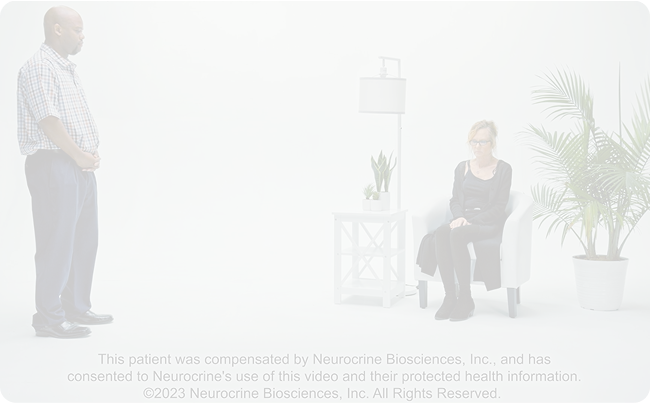

~2 mins
•Oct 2024
Why Do the AIMS?
The MIND-TD questionnaire, summarized below, gauges the physical, mental, and daily life impact of patients’ symptoms and can help start the discussion that is part of assessing TD.7
Part 1: The MIND-TD questions can be asked in person or via telehealth
Movement
Do you have extra or unwanted movements in your body?
Impact
Do you feel embarrassed or self-conscious about movements in your body?
Notice
Has someone else seen extra movements in your body?
Daily Activities
Do any movements cause problems during your daily routine?
Part 2: If tardive dyskinesia is suspected, Part 2 can help guide next steps
Thorough Interview
Learn more by asking the right questions
Differentiate
Look for movements while the patient performs activation maneuvers and is at rest
Guidelines recommend a brief clinical assessment for TD at each visit for patients taking antipsychotics.7 What does this look like?
If TD is suspected, a formal clinical assessment will be needed.8 This involves including a medical history and use of a structured tool, such as the Abnormal Involuntary Movement Scale (AIMS), which can support diagnosis and establish severity.2 A structured assessment with a tool such as the AIMS is recommended by the APA guidelines every 6 months for higher risk patients.1
For the AIMS, symptoms are measured across an array of observer-rated metrics, including facial/oral and body movements, global judgments, and dental status. The assessment consists of 12 items that can be scored from 0 to 4. Items 1-7 assess movements in the face, extremities, and trunk. Items 8-10 require global judgments, including regarding the severity of incapacitation and the level of patient awareness. Items 11 and 12 assess dental impacts.9
The Abnormal Involuntary Movement Scale (AIMS): Understanding the What, Why, When, and How

Now learn how to differentiate TD from other movement disorders.
References
American Psychiatric Association. The American Psychiatric Association Practice Guideline for the Treatment of Patients With Schizophrenia. 3rd ed. American Psychiatric Association; 2021.
Caroff SN, et al. J Clin Psychiatry. 2020;81(2):19cs12983.
McEvoy J, et al. Qual Life Res. 2019;28(12):3303-3312.
Ward KM, Citrome L. Neurol Ther. 2018;7(2):233-248.
Data on file.
Jain R, et al. J Clin Psychiatry. 2023;84(3):22m14694.
Lundt L, et al. Development of a MIND-TD questionnaire as a screening tool for tardive dyskinesia. Poster presented at: Neuroscience Education Institute Congress; November 4-7, 2021; Colorado Springs, CO.
American Psychiatric Association. The American Psychiatric Association Practice Guideline for the Treatment of Patients With Schizophrenia. 3rd ed. American Psychiatric Association; 2021.
Munetz M, Benjamin S. Hosp Community Psych. 1988;39(11):1172-1177.
Based on your answers, your AIMS dyskinesia total score is:
See expert ratings and commentary below:
Facial and Oral Movements
Extremity Movements
Trunk Movements
Clinical Professor of Psychiatry
University of California
San Diego, CA
Muscles of facial expression:
In the upper face I did note excessive blinking, but it was mild, so I rated item 1 as a 1.
Lips and perioral area, jaw, and tongue:
The movements in these body regions are prominent, moderate in severity, and seen throughout the exam, especially during distraction. For this reason I rated items 2, 3, and 4 with scores of 3.
Upper extremities, lower extremities, and neck, shoulders, and hips:
I did not see any movements in the upper or lower extremities or in the neck, shoulders, or hips, so items 5, 6, and 7 were all rated a 0.
Professor of Neurology
University of South Florida
Director, Parkinson’s Disease and Movement Disorders Center
Tampa, FL
Muscles of facial expression:
I did not see any abnormal movements in the upper half of the patient’s face, so I rated item 1 a 0.
Lips and perioral area:
The patient has abnormal movements in the lips and perioral region. These are mostly mild in amplitude and occur during most of the exam, hence I rated them a 2. There is one burst of moderate amplitude perioral movements during finger tapping, but this only occurs during some of the exam, so my rating would still be a 2 for this item.
Jaw:
The patient has lateral jaw movements that are mostly mild in amplitude and present during most of the exam, hence I rated this item a 2.
Tongue:
In this patient’s case, her most severe tongue movements occur when the tongue is inside her mouth. I would describe these as moderate due to the excursion of the tongue to the sides and roof of the mouth. I don’t feel they are severe as the tongue doesn’t protrude beyond the lips and the intensity of the movements is not great. The movements are present during most of the time that her mouth is open, and I therefore rated them a 3.
Upper extremities:
The patient has low amplitude movements in the arms when we are observing her hands at rest in her lap. We don’t see these elsewhere in the video, so since they are low amplitude and not present during most of the exam, I think these are best rated as a 1.
Lower extremities:
While observing her hands resting in her lap, she has some adduction movements in her legs. These are low amplitude and not observed elsewhere in the video, so I rated them a 1.
Neck, shoulders, and hips:
I did not see abnormal movements in these areas, so I rated this item a 0. At one point in the video, her left shoulder appears elevated, and at another point her right shoulder appears elevated. However, I was not convinced that these represented abnormal movements because there were no other signs of dystonic posturing in this body region, such as a turned or tilted head or neck.
A limitation of practicing AIMS rating using short video clips is that we skip around in the examination of body parts. During an actual examination, one should take an orderly approach.
Note that the ratings should capture both the amplitude and persistence of the abnormal movement. For example, a moderate-amplitude movement that is only present during some of the exam may be a 2, whereas a moderate-amplitude movement that is present during most of the exam may be a 3. Keep in MIND that in this short video, there may not be as much information available about the persistence of the patients’ abnormal movements when compared to full-length exams.
A lot of times, when performing the AIMS exam, I can narrow down the potential rating to 2 possible scores. Then, through careful observation, I can decide which of those 2 possible scores best captures the amplitude and persistence of the abnormal movement. Being consistent from exam to exam and from patient to patient is key.
The AIMS provides a standardized scoring system to evaluate and follow changes in the abnormal movements of tardive dyskinesia. Remember, however, that the AIMS score is only part of the picture; one must also assess the social, emotional, and functional impacts of the abnormal movements to assess their full impact.